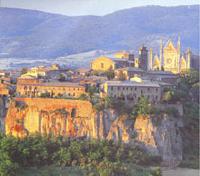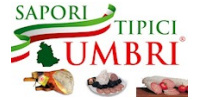 |
Fully aware of its unique beauty and keen to preserve the fragile rocky plateau on which it stands, the city of Orvieto has implemented a ban on visitor car access into the city. Visitors should therefore leave their car in the valley below and take the funicular from the rail station up into the heart of the old city, past the ancient Albornoz fortress. Alternatively, at Campo della Fiera there is a large covered parking and a system of escalators and lifts that also take visitors up to the old Medieval quarter. A number of efficient minibus connections also guarantee a fast access up to town.
For a full view of the breathtaking cityscape of Orvieto it is well worth climbing to the top of the 13th century Torre del Moro, the most central and highest point in the city, which commands a 360° view over the rooftops and the lush surrounding countryside.
The heart of the city is Piazza del Duomo, a supremely elegant space onto which face palazzi and the imposing Duomo. Its dazzling façade, shining with polychrome marble and mosaics, is one of the finest examples of Gothic architecture in central Italy.
The interior contains masterpieces by Luca Signorelli, who painted the Anti Christ Episodes, The End of the World, The Resurrection of the Flesh, The Elect and the Reprobates and a spectacular Last Judgement in the chapel of San Brizio. Beato Angelico painted the angels in the ceiling
Begun in 1290, the buiding of the cathedral continued for some centuries. The Torretta at the corner of Via del Duomo for centuries rang the time for the workers toiling at the construction of this massive building.
But as well as its Medieval and Renaissance monuments, Orvieto also has important Etruscan remains, such as the two burial grounds situated beneath the city: the Necropoli del Crocifisso del Tufo – Loc. San Martino – Orvieto Scalo, and the underground level of the city.
Enlarged during the Middle Ages and put to a variety of uses ranging from cisterns to pigeon breeding, the labyrinth of underground passages that run beneath the city of Orvieto grew to such proportions that it would be more appropriate to refer to it as a second city that has been literally hewn out of the rock foundations of the buildings above. This hidden city is open to the public, which is allowed to follow a precise itinerary organised by Orvieto Underground. The Pozzo di San Patrizio well, designed by Antonio da Sangallo for Pope Clement VII in the 16th century is also open to the public.
Divided between the Museo Claudio Faina, the Museo Archeologico and the Museo dell’Opera del Duomo, the Collezione Civica is also of great interest.








